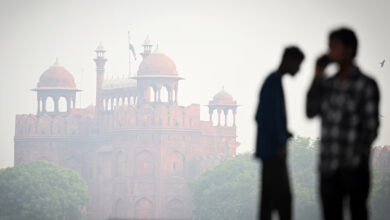The clock is ticking, and it’s almost time for the infamous black cloud that usually starts forming in mid-September.
But this year could potentially bring darker days than ever. Environmentalists are gathering their gear to campaign for healthier lifestyles and to warn about the biggest culprit for Cairo’s air pollution: the private car.
Many of us know that our hands are dirty. We’ve each been part of the culture that is slowly destroying our health, quality of life, and the beauty of our cities in return for an illusion of a better life.
The black cloud has been haunting Cairo since 1999. Deaths associated with it haven’t really been monitored, but a simple comparison with the London smog of 1952 can tell us that, yes, people do die from air pollution – about 4000 died in that case. That’s in a city with much lower population at that time. The World Health Organization has also associated air pollution with everything from lung irritation and deterioration of mental health to cancer.
This year in Egypt is special. The 2011 black cloud, and the implications of the revolution, will keep us environmentalists in great suspense. We’re in a period of chaos and even the little control over municipal waste burning in the peripheries of Greater Cairo is lost, and so is the control over the burning of rice straw, the major culprit in earlier years.
But there is a catch this time, and all arguments are worth mentioning. Some of the suspense revolves around a counterintuitive speculation that the loss of control over rice burning expected this year might actually be good. After all, the imposed ban over rice straw burning had previously driven many farmers to burn in the darkness of the night when inspectors can’t see them. This was actually the worst time to burn, when the meteorological condition was least appropriate.
An invisible low-altitude air layer or “cap” over Cairo forms every night and builds up pollution, a phenomenon called the “thermal inversion” that’s common in autumn. This only breaks up when the sun rises next day to stir the atmosphere with its heat. This ventilates our city once more, hence the more favorable hours for open burning.
So who knows? Maybe this year, with farmers comfortably violating the ban in broad daylight during more favorable conditions, the impact on downwind Cairo will be less than expected. The immediately neighboring communities in the Delta, however, will still suffer.
But optimists should remember that studies on Cairo’s air pollution show that a whole third has been attributed to the transportation sector alone. So now that the rice straw pollution might possibly fade away, the increasing car pollution will catch up, and we’ll see a yet darker black cloud.
Making matters worse, in the wake of the swine flu outbreak, the panic-driven military-style culling of the entire swine population in 2009 caused an alarming surplus of waste previously fed to the pigs. Half of our 10,000 tons per day of generated waste that was edible organic matter for them is today unusable and left to rot and burn in our air, adding more ingredients to the black cloud. Alternative uses for waste are not developing fast enough.
But the transportation sector still tops the list of city polluters. There are more than 4.2 million vehicles in Egypt, many of which are continuously coughing a mix of toxic fumes. There are a further 200,000 new vehicles hitting the streets every year, taking over the last remaining spaces that children used to play in. This is not to mention the alarming increase in vehicle numbers, doubling seven-fold in my expected lifetime, and the fact that fuels are cheap (substantially subsidized by the government). We are driving ourselves off a cliff in terms of energy dependence. Furthermore, with more and more Egyptians embracing the “modern” consumerist lifestyle, the rising vehicle emissions of our rapidly urbanizing population will overshadow any efforts for emission reductions from other sources.
Unlike rice straw, this polluter comes in a bigger package of adverse impacts: economic, social and environmental impacts that include noise, heat, congestion, loss of time, deterioration of cultural heritage, occupation of public spaces, stress, and physiological problems related to the sedentary lifestyles that we have surrendered to, among other impacts. It’s a slow killer.
It's no wonder that 30 percent of Denmark’s workforce – the world’s happiest population, according to many surveys – has come to commute to work by bicycle. It's no wonder that the most popular mayor of Bogota was the one who made sweeping measures to transform the public transportation network after building cycling infrastructure and pedestrianizing many streets, putting Bogota on the map of most sustainable cities. Even the US has been taking sweeping measures to eradicate their “gas-guzzler” sport utility vehicles (SUVs), which are, unlike in Egypt, totally not sexy anymore. The healthy biker, the environmentally-conscious public transport user, or even the carpooler are becoming the popular ones, admired for their genuine social consciousness and environmental responsibility.
De-marketing the private vehicle in many cities is increasingly being recognized as a cross-cutting solution to so many ailments of our dense cities, and healthy lifestyle choices are now in fashion.
If there is one quick-win for us to see clear skies again and enjoy our city, it is to combat this outbreak of private vehicles. If panic-driven crusades against pigs and birds were so effective in Egypt, then let’s cry “car-flu” this time and really save our future.




